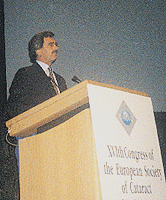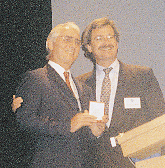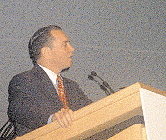ESCRS looks at the value of cataract surgery, halting PCO, and the frontiers of eye care
Documenting and analyzing surgical outcomes set the tone for this important European meeting.
NICE, France - The European Society of Cataract and Refractive Surgery (ESCRS) might be a subspecialty organization, but its annual meeting held here showed how far-reaching the society is becoming in European ophthalmology.
In addition to an extensive scientific lecture program focusing on cataract and refractive surgery, the ESCRS offered a Refractive Surgery Diploma Certification Course; one-day programs for residents and nurses; special sessions on public-health issues in eye care like outcomes and cataract surgery in very elderly patients; and Scientific Research Symposia on glaucoma surgery and laser phacoemulsification, among other topics. Throughout the meeting, the ESCRS leadership focused on the socioeconomics of ophthalmology, urging participants to pool data documenting the benefits of high-quality eye care for the consideration of government health authorities.
Evaluation and documentation
 ---ESCRS board members Thomas Neuhann, MD, and Philippe Sourdille, MD, join here with Jean-Luc Seegmuller, MD, head of the French union of ophthalmologists and of the ophthalmology section of the Union of European Medical Specialists, to announce that the ESCRS has agreed to share its outcome study data with the French union for use in advising the health ministry on reimbursement and other issues.
---ESCRS board members Thomas Neuhann, MD, and Philippe Sourdille, MD, join here with Jean-Luc Seegmuller, MD, head of the French union of ophthalmologists and of the ophthalmology section of the Union of European Medical Specialists, to announce that the ESCRS has agreed to share its outcome study data with the French union for use in advising the health ministry on reimbursement and other issues.
At the Clinical Research Symposia, held the day before the ESCRS meeting proper began, one of the major topics of discussion was evaluation and outcomes research. The need for European ophthalmologists to measure and document the effect of their care on patient well-being is increasing, according to symposium organizers.
If doctors do not begin to document the value they are providing to patients and thus their value to the national health organizations that oversee their payment "Brussels will be deciding this value for us," said Eugenio Leite, MD, of Coimbra, Portugal. This view was shared by many of the day's presenters.
The evaluation symposium was organized to examine the measurement instruments available to ophthalmologists for documenting outcomes, and to look at some European epidemiological studies that have been done to date.
Mats Lundström, MD, of Karlskrona, Sweden, discussed the Catquest questionnaire, an instrument used to measure cataract outcomes in more than 4,700 patients in Sweden. Administered preoperatively and postoperatively, Catquest is designed to measure changes in patients' ability to perform tasks of daily life, as well as visual function.
Surprisingly, and much to the consternation of the audience, 10% of patients responding to the Catquest reported no benefit from cataract surgery, according to Dr. Lundström.
Manfred Tetz, MD, of Berlin presented software he has developed for objective evaluation of posterior capsular opacification (PCO). Called EPCO, the software allows the user, in 30 to 60 seconds, to assign a numerical grade to the severity of a patient's PCO. This information is then easily entered into a database that allows further manipulation of the data for example, comparison of results with two lens materials or two surgical techniques.
Didier Ducournau, MD, of Nantes, France, a vitreoretinal subspecialist, presented a software package used by most French vitreoretinal surgeons to record the outcomes of their surgeries. Dr. Ducournau has offered to cooperate with the ESCRS in designing similar software to document cataract surgery outcomes.
Gathering, sharing data
 ---ESCRS President Thomas Neuhann, MD, announced that a practice profile survey, similar to one conducted by the American Society of Cataract and Refractive Surgery, will be mailed to ESCRS members.
---ESCRS President Thomas Neuhann, MD, announced that a practice profile survey, similar to one conducted by the American Society of Cataract and Refractive Surgery, will be mailed to ESCRS members.
At the plenary Opening Session of the ESCRS, society President Thomas Neuhann, MD, announced that a practice profile survey, similar to one that has been conducted for more than 10 years by the American Society of Cataract and Refractive Surgery (ASCRS), will be mailed to ESCRS members following the meeting. He said original plans had called for the survey to be completed by meeting participants on-site, but there were too many distractions at the meeting to ensure thoughtful and complete responses to the questionnaire.
Dr. Neuhann said he hoped the data generated by the survey would allow European ophthalmologists to get some perspective on what their colleagues are doing, and give an accurate picture of ophthalmic practice in Europe.
The ESCRS survey, like the one done by ASCRS, has been designed by David V. Leaming, MD, of Palm Springs, U.S.A.
At a press conference later in the meeting, members of the ESCRS board announced that the society has agreed to share with the French union of ophthalmologists data generated by outcome studies undertaken by the ESCRS. The union, which consults with the French government regarding reimbursement for medical procedures, may use the data from ESCRS studies to justify increasing or maintaining funding levels for ophthalmic surgery, said Dr. Sourdille, who spoke at the press conference.
Jean-Luc Seegmuller, MD, head of the French union and of the ophthalmology section of the Union of European Medical Specialists, noted that this historic collaboration with ESCRS fittingly begins in 1998, which has been declared the European Year of Vision.
Preventing PCO
 ---Jorg Krumeich, MD (left), recipient of this year's Binkhorst Medal, is congratulated by ESCRS President Thomas Neuhann, MD, following his award lecture, "My Contribution to Therapeutic and Refractive Surgery."
---Jorg Krumeich, MD (left), recipient of this year's Binkhorst Medal, is congratulated by ESCRS President Thomas Neuhann, MD, following his award lecture, "My Contribution to Therapeutic and Refractive Surgery."
One of the hot topics of the ESCRS meeting was prevention of posterior capsular opacification (PCO). Researchers are finding that several intraoperative factors can greatly decrease the incidence of PCO following cataract surgery. These include use of capsular tension rings, use of IOLs with squared-off optic edges and use of copious hydrodissection and thorough cortical clean-up.
"A discontinuous, sharp bend in the capsule" halts migration of lens epithelial cells through "contact inhibition," said Okihiro Nishi, MD, of Osaka, Japan, in a keynote address at the PCO session. Building on previous animal studies, Dr. Nishi demonstrated that cell migration can be significantly interrupted by either a capsular tension ring or the squared edge of an IOL.
Using the EPCO software of Dr. Tetz, described above, Dr. Nishi found reduced growth of epithelial cells on the posterior capsules of patients implanted with either capsular tension rings, AcrySof (Alcon Surgical, Fort Worth, U.S.A.) acrylic IOLs with truncated optic edges, or PMMA IOLs of similar design. This latter result suggests that "a reportedly low incidence of PCO in eyes with an AcrySof IOL is because of its rectangular optic design that can create a sharp bend in the capsule," Dr. Nishi said.
Dr. Nishi suggested that to help prevent PCO, lens designs should include sharp optic edges, posterior convexity of the optic and a steep haptic angle. Lens materials may also help inhibit growth. And use of a continuous curvilinear capsulorrhexis smaller than the optic diameter can also be a contributing factor.
Rupert Menapace, MD, of Vienna reported one-year results in 50 patients who received a capsular tension ring and a Hydroview IOL (Bausch & Lomb Surgical, Rochester, U.S.A.) in one eye, and the same lens with no ring in the other. He said that the capsular tension ring did not prevent PCO entirely, but significantly inhibited growth. The ring group also showed no capsular folds at 1 year, significantly less than the group with no rings.
David J. Apple, MD, of Charleston, U.S.A., agreed with the other presenters in his discussion of a study of 300 post-mortem human eyes. The study conducted at his center confirmed that IOL optics with truncated edges enhance the barrier effect against PCO, he said.
Dr. Apple called cortical clean-up the first line of defense against PCO and the barrier effect of the optic the second line. He said during a discussion period that if surgeons begin to pay attention to these factors, it is possible to imagine the end of PCO as a sight-threatening problem.
Viscoelastic review
 ---Spencer P. Thornton, MD, president of the American Society of Cataract and Refractive Surgery, spoke at this year's Opening Ceremony on cooperation between his organization and the ESCRS.
---Spencer P. Thornton, MD, president of the American Society of Cataract and Refractive Surgery, spoke at this year's Opening Ceremony on cooperation between his organization and the ESCRS.
Steve A. Arshinoff, MD, of Downsview, Canada, presented results of a review of the worldwide literature (in English) for the last 20 years on viscoelastics, specifically looking at endothelial cell protection and postoperative intraocular pressure (IOP) spikes.
He said different viscoelastics appear to provide different levels of protection of endothelial cells. The review also revealed that all viscoelastic materials are associated with IOP spikes above 30 mm Hg at 8 to 12 hours after surgery. These spikes occur in more than 20% of cases, Dr. Arshinoff said. The IOP always returned to normal at 5 to 7 days postop.
Based on these findings, he made two blanket recommendations: always remove viscoelastic materials at the end of surgery, and always use IOP-reducing agents.
Of 14 presentations in a session devoted to viscosurgery, half mentioned Healon 5 (the new viscoelastic from Pharmacia & Upjohn) in the title. And although it was not named in the title of his lecture, Dr. Arshinoff described the development of Healon 5 as a "viscous-retentive" material.
"Healon 5 behaves as a very cohesive product when under low stress," he said. "But as we increase the stress on the molecule, it fractures. It is not dispersive, but it achieves the same things that dispersive viscoelastics do." Dr. Arshinoff used the example of phacoemulsification as the type of stress under which the Healon 5 molecule would fracture, thus leaving a protective coating on the internal structures of the eye while any viscoelastic that occludes the phaco tip is sucked out of the anterior chamber.
Dr. Tetz presented the results of a prospective study comparing endothelial cell loss 90 days postoperatively in 62 patients randomly assigned to undergo cataract surgery in which one of four different viscoelastics was used. He found cell loss to be statistically significantly lower in the Healon 5 group compared with the others.
H. Burkhard Dick, MD, of Mainz, Germany described his laboratory measurement of the rheological properties of 20 different viscoelastics, in which he found not only major differences between various substances, but also some differences between his measurements and the values provided by manufacturers.
Cataract in very elderly
On the second day of the program, the multi-track format was trimmed to a single 90-minute plenary session devoted to "Cataract Surgery in the Very Elderly," which was defined as patients 85 years of age and older.
A number of speakers tried to quantify the special characteristics of the over-85 population. Ulf Stenevi, MD, of the University of Lund, presented data from the Swedish cataract registry of more than 236,000 cataract surgery patients. Approximately 10% of the registry cases were patients in the "very elderly" range of age 85 and older. Some type of comorbidity (retinal disease, glaucoma, etc.) was present in approximately 50% of the very elderly, compared with approximately 35% of the 65- to 85-year olds and 20% of those under age 65.
Dr. Stenevi said that although visual acuity results of cataract surgery are "not so good" in the very elderly compared with younger patients, the absence of higher complication rates indicate that "there is no reason not to do surgery in the very elderly."
Olivia Serdarevic, MD, of Cornell University, New York, and Hotel Dieu, Paris, noted that "luckily, the inflammatory response is greatly reduced in the elderly," and therefore inflammation-related complications are generally reduced. However, the presence of inflammatory disease in a number of these patients can present special problems. L. Scoroli, MD, of the University Eye Clinic of Bologna, Italy, reported that the incidence of dementia may be up to 50% in the very elderly.
Eeva-Liisa Maunuksela, MD, PhD, of Helsinki University Eye and Ear Hospital, discussed how special considerations like dementia, physical frailty or illness, or use of systemic medications should be considered together when making decisions about anesthesia and sedation for cataract surgery in this population.
"Cataract surgery itself is not dangerous to their health," Dr. Maunuksela said, "but general anesthesia might be.... The most dangerous time is not during surgery, but for the first 2 to 3 days afterward." For this reason, she recommended surgeons consider hospitalization for the first three postoperative days of very elderly cataract patients.
In the interest of avoiding progressive postoperative visual impairment from PCO, Daniel Lebuisson, MD, and coworkers at the Hôpital Foch in Paris studied the use of posterior capsulorrhexis at the time of cataract surgery in the very elderly. It seemed unreasonable to allow PCO to develop in a significant number of these patients, said Dr. Lebuisson, when it could be expected that 35% were likely to die within 24 months. Immediate posterior capsulorrhexis could preserve a clear visual pathway for the rest of their life expectancy.
The study enrolled 47 patients, 32 of whom were followed for 6 to 12 months after cataract extraction, 3- to 4-mm posterior capsulorrhexis and foldable IOL implantation. There were no retinal detachments and only one case of macular edema in a patient with age-related macular degeneration, which was similar to the results in a group of age-matched controls. Dr. Lebuisson said further study is needed, but immediate posterior capsulorrhexis in the very elderly seems to be a reasonable option.
Pediatric refractive surgery
The last day of the ESCRS program included discussion of an even more avant-garde topic: pediatric phakic intraocular implants.
"In cases of severe anisometropia... refractive surgery can be the unique [treatment] option for an intractable amblyopia," said L. Lesueur, MD, of Toulouse, France. She cited papers in the peer review literature as well as a presentation at the most recent meeting of the ASCRS in which PRK and LASIK (sometimes bilaterally) had been used in an effort to prevent amblyopia in children with severe anisometropia.
"We preferred to perform an intraocular refractive surgical procedure for several reasons," Dr. Lesueur said. "This technique is reversible.... The cornea is preserved, and PRK or LASIK could be done later for residual myopia. In this preliminary study, no anatomical complications were observed, and in all cases observed function was good."
The Implantable Contact Lens (ICL, STAAR Surgical, Monrovia, U.S.A.) was used in four patients 3 to 15 years of age with amblyopia resulting from unilateral high myopia (from 8 to 18 D) that could not successfully be corrected with spectacles or contact lenses. According to Dr. Lesueur, a detailed informed consent was obtained and the surgical technique was similar to ICL implantation in adults. Follow-up ranged from 5 to 15 months.
"No inflammation reaction was observed, and intraocular pressure was stable," Dr. Lesueur said. Sufficient "vaulting" (space between the ICL optic and the crystalline lens) was obtained.
"Postoperatively, visual acuities improved, with a gain of two lines or more of best-corrected visual acuity with spectacles in all cases. We now see the decrease of exotropic strabismus. ... Finally, the quality of life of these children was improved with regard to school, games and psychological status."
In the discussion period following Dr. Lesueur's presentation, a member of the audience questioned whether this approach was merely substituting the risk of cataract or even more serious problems for the risk of amblyopia. Dr. Lesueur and fellow speaker Jean-Louis Arne, MD, replied that experience with the ICL indicated that cataract would not form so long as the vaulting necessary to prevent contact with the crystalline lens was obtained, and that long-term results with the ICL were good. Discussants on the panel for the session acknowledged the highly innovative nature of pediatric refractive surgery but noted that such procedures might some day be the answer for amblyopia-inducing ametropias.
